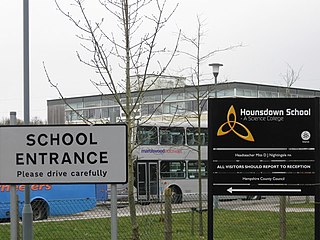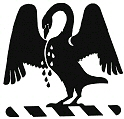In the education systems of England, Northern Ireland, Wales, Jamaica, Trinidad and Tobago and some other Commonwealth countries, sixth form represents the final two years of secondary education, ages 16 to 18. Pupils typically prepare for A-level or equivalent examinations like the IB or Pre-U. In England, Wales, and Northern Ireland, the term Key Stage 5 has the same meaning. It only refers to academic education and not to vocational education.

Herne Bay is a seaside town on the north coast of Kent in South East England. It is 6 miles (10 km) north of Canterbury and 4 miles (6 km) east of Whitstable. It neighbours the ancient villages of Herne and Reculver and is part of the City of Canterbury local government district, although it remains a separate town with countryside between it and Canterbury. Herne Bay's seafront is home to the world's first freestanding purpose-built Clock Tower, built in 1837. From the late Victorian period until 1978, the town had the second-longest pier in the United Kingdom.

The Judd School is an 11–18 voluntary aided, grammar school and sixth form in Tonbridge, Kent, England. It was established in 1888 at Stafford House on East Street in Tonbridge, where it remained for eight years before moving to its present location on Brook Street, in the south of the town. Founded by the Worshipful Company of Skinners, it was named after 16th century merchant Sir Andrew Judde, whose endowment helped fund the school. The Skinners' Company maintains close links with the school and makes up the majority of the governing body.
Greenhead College is a sixth form college, and former grammar school, located in Huddersfield, in the county of West Yorkshire, England. The current principal is Simon Lett. With over 2,700 students, it is a large sixth form college, attracting students from as far afield as Wakefield, Manchester, Barnsley, Bradford, Leeds, Halifax, Wetherby and even Wales. It is located next to Greenhead Park which is one of the largest parks in Huddersfield.

Truro School is a coeducational private boarding and day school located in the city of Truro, Cornwall, England. It is the largest coeducational independent school in Cornwall with over 1050 pupils from pre-prep to sixth form. It is a member school of the Headmasters' and Headmistresses' Conference.

Dartford Grammar School for Girls is a grammar school for girls in Dartford, Kent, England. Formerly known as Dartford County School, the school opened in 1904. It is the sister school of Dartford Grammar School for Boys.

Highfields School is a coeducational secondary school and sixth form located in Matlock, Derbyshire, England. At the time of its September 2012 Ofsted inspection, the school had 1175 pupils on roll aged 11–18, with 215 in the sixth form. It is split across two sites in the town 1.8 miles apart.

Hounsdown School is a secondary school in Totton, near Southampton, Hampshire, England The school has 1,215 pupils, spanning ages 11 to 16. Classes are held in renovated 1960s buildings and new specialist blocks built since 2000.

Holcombe Grammar School is a grammar school with academy status in Chatham, Kent, England. It is a selective school. From the 2017-18 academic year, the school planned to become co-educational and remain selective in the lower school. This was blocked - and later approved - by the Department for Education with co-educational admission desired for the 2018/19 school year. The school has changed name in advance of becoming co-educational and plans to change all references from "Chatham Grammar School for Boys" to "Holcombe Grammar School" over academic year 2016/17.

Queen Elizabeth's Grammar School is a selective co-educational grammar school with academy status in Faversham, Kent, southeast England. It was formed in 1967, when the Queen Elizabeth 1 Grammar School for Boys and the William Gibbs School for Girls merged and moved into new accommodation opposite.

Harris Academy Peckham is a coeducational academy in Peckham, in the London Borough of Southwark. Catering for pupils from the ages of 11 to 18, the school specialises in the curriculum areas of Business and Enterprise, ICT, and the Performing Arts.

Kirk Balk Academy is a secondary school located in Barnsley, South Yorkshire, England. It is part of the Northern Education Trust. The school mainly serves students living in its immediate area: Birdwell, Hoyland, Jump, Tankersley, Elsecar, Wombwell and Pilley.

Fulston Manor School is a secondary School with academy status in Sittingbourne, Kent. The head teacher is Mrs Susie Burden. It teaches years 7–13.

The Skinners' Kent Academy is a secondary school with academy status in Royal Tunbridge Wells, England. The academy is rated outstanding by Ofsted.
The North School is a coeducational secondary school and sixth form situated in the town of Ashford, Kent, England.
The Royal Harbour Academy is a coeducational secondary school and sixth form located over two sites in Ramsgate in the English county of Kent.

The Abbey School is a non-selective secondary school in the town of Faversham in Kent, United Kingdom. Founded with the amalgamation of Ethelbert Road Boys School and Lady Capel School for Girls in 1983, the school consists of 1056 pupils from the ages of 11–19. The school became an academy in August 2011 and joined The Howard Academy Trust on April 1st 2023
The Frank Montgomery School was a mixed-gender secondary modern school in the village of Sturry near Canterbury in east Kent. It was founded in 1935 and closed in 2007, when the site and school roll was taken over by Spires Academy.

Riverside Campus is an 11-18 mixed, secondary free school and selective sixth form situated in Barking Riverside, London, England. It is one of the largest schools in the London Borough of Barking and Dagenham, with currently over 1,200 students on roll.

















